Nvidia could set market direction

Oil prices have fallen recently on easing tensions between Iran and Israel, but also on weaker in the US economy growth. Extended production cuts at the Opec meeting on 1 June may slow or reverse the price decline. Although the Q1 earnings season is coming to an end, Nvidia's report today will be important for the direction of the markets.
Case of the week: Expected extension of OPEC production cuts could boost oil prices
The oil price has retreated from the YTD highs of April, when tensions between Israel and Iran peaked. At around the same time, Ukrainian attacks on Russian refineries fueled fears of a wider Ukrainian attack on Russian oil infrastructure, increasing the perceived risk of a potential oil supply shock.
Like what happened in the autumn of 2023, geopolitical concerns have quickly faded. In addition, the main leading indicators for US growth have recently been weaker than expected. As a result, the oil price has come under pressure in recent months, having peaked at over USD 90 per barrel.
Extension of oil production cuts likely
OPEC+ will hold its next meeting in less than two weeks, on 1 June. A key focus will be whether the voluntary production cuts agreed in November 2023 (2.3m barrels per day - bpd) will be extended again. Saudi Arabia is likely to take this position, as it probably wants higher oil prices than at present. If not extended, the cuts will expire at the end of June. Failure to curb supply from OPEC+ members could lead to further price falls. It is noteworthy that the biggest OPEC production cuts since the financial crisis have not pushed prices higher. OPEC expects robust oil demand growth of 2.25m barrels per day in 2024. In contrast, the IEA forecasts slower growth of 1.1m bpd. According to the IEA, the long-term growth trend is 1.3m bpd.
The Iran-Israel conflict is still an unknown. However, tensions seem to have eased recently. If there is further retaliation from Israel, including attacks on Iranian oil infrastructure, it risks alienating its allies. Similarly, the fact that Ukraine is finally receiving increased US arms assistance should also reduce the incentive to target, for example, Russian oil and gas pipelines. However, these ongoing conflicts are far from over and tensions could quickly rise again.
Given the recent weakness, one might expect oil to strengthen heading into the June meeting. However, a key resistance level of USD 84 per barrel (MA200) for Brent must be overcome first. Below today's price, we see a key support level at USD 82 per barrel (50% retracement of the rally from the December lows).
Brent (USD per barrel), one-year daily price chart

Brent (USD per barrel), five-year weekly price chart

Macro comments
After falling from 4.83% on 14th May to 4.73% on 16th May following the lower US Consumer Price Index figures for April, the US 2-year Treasury yield was back at 4.86% on Monday 20th May. Since then, it has fallen back to 4.79%.
As of Friday 17 May 2024, approximately 465 S&P 500 companies (93% of all companies) have reported their Q1 2024 results. 78% have reported positive earnings surprises and 60% have reported positive revenue surprises.
The best performing sectors in terms of Q1 2024 earnings performance have been Health Care, Information Technology and Consumer Staples with 87% of Q1 reports beating expectations. Meanwhile, Consumer Discretionary, Real Estate and Utilities are the worst performers, with only 72%, 69% and 61% of Q1 2024 earnings beating expectations.
The average earnings growth rate for S&P500 companies in Q1 2024 has increased from 5.4% to 5.7% in the last week. As of 31 March 2024, the earnings growth rate for S&P500 companies in Q1 2024 was estimated at 3.4%. For Q2 2024, 54 S&P500 companies have issued negative earnings guidance, while 37 S&P500 companies have issued positive earnings guidance.
Today, Wednesday 22nd May, we get an interim report from Nvidia. Thursday 23 May is dominated by purchasing managers' indices for May from Japan, France, Germany, the Eurozone, the United Kingdom, and the United States.
US, Eurozone and UK manufacturing Purchasing Managers Indices (PMIs), June 2022 to May 2024 (forecast)
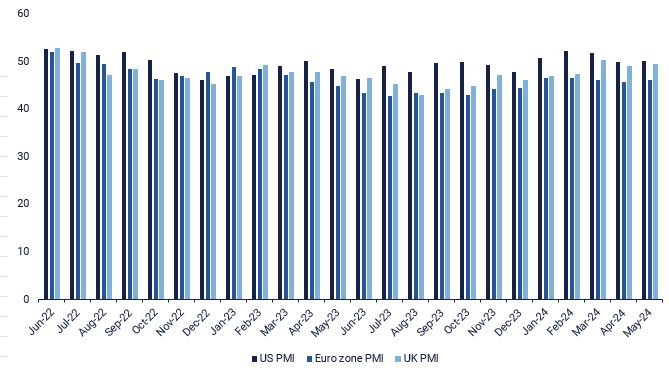
Can the NVIDIA interim report provide any new short-term fuel?
The S&P 500 is currently trading slightly lower ahead of NVIDIA's Q2 earnings report, which is due out after the US close today. As you can see on the chart below, the index is trading close to support formed by previous resistance. NVIDIA could be the trigger for the next wave, up or down.
S&P 500 (in USD), one-year daily chart
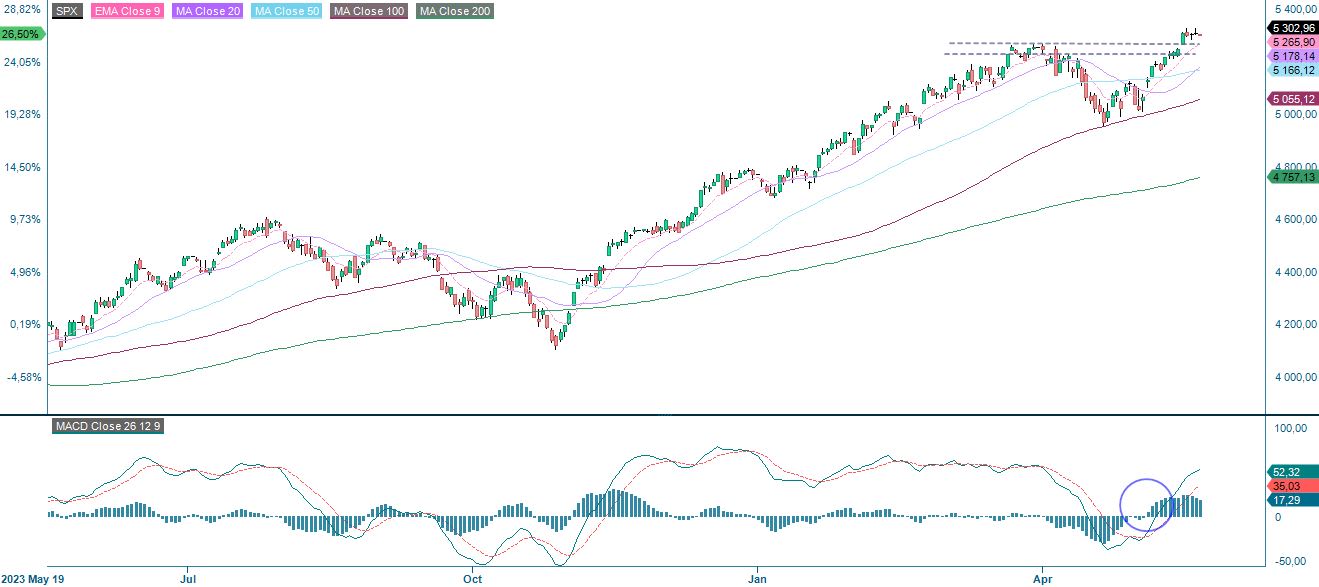
S&P 500 (in USD), weekly five-year chart

The same situation applies to the Nasdaq 100.
Nasdaq 100 (in USD), one-year daily chart
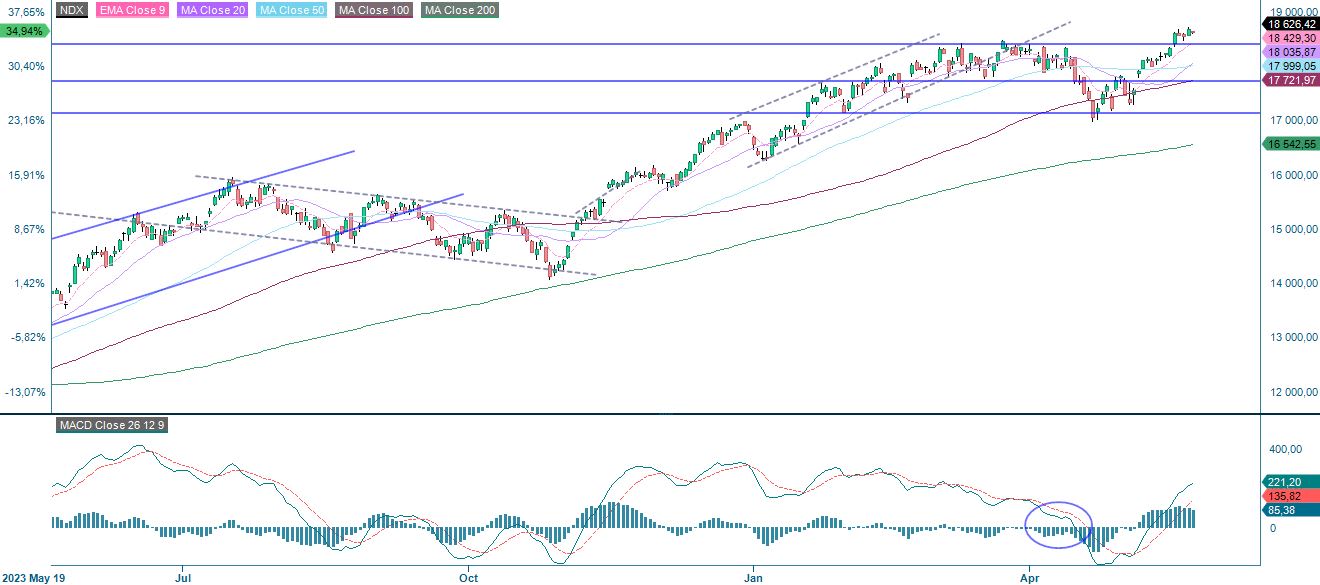
The Nasdaq 100 rather than the S&P 500 looks very convincing from a strict technical perspective on the weekly chart. A target level on the upside has therefore been reached and one could consider reducing the size of potential long positions.
Nasdaq 100 (in USD), weekly five-year chart

Sweden's OMXS30 managed to bounce on the EMA9 but resistance is relatively close, around 2,630. The sentiment set by the NVIDIA report is likely to affect the OMXS30 as well. A break below EMA9 and the next support is the MA20, currently at 2,580.
OMXS30 (in SEK), one-year daily chart
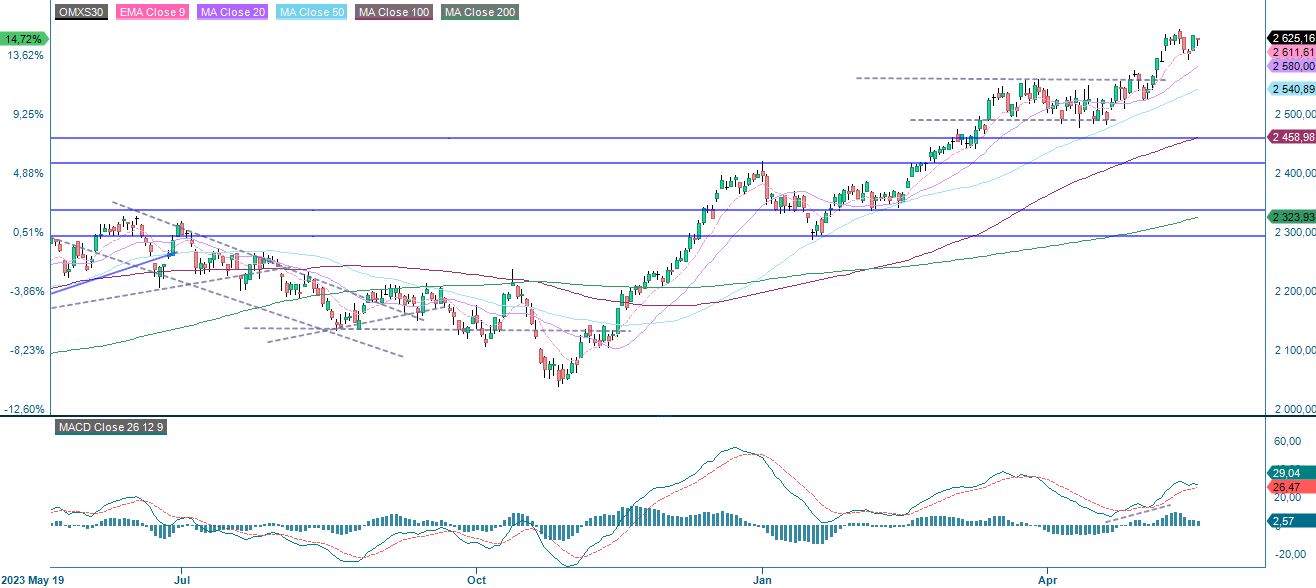
OMXS30 (in SEK), weekly five-year chart

The German DAX is stuck above EMA9 under positive but bearish momentum. The next level on the downside is around 18,400 where MA20 meets.
DAX (in EUR), one-year daily chart

DAX (in EUR), weekly five-year chart
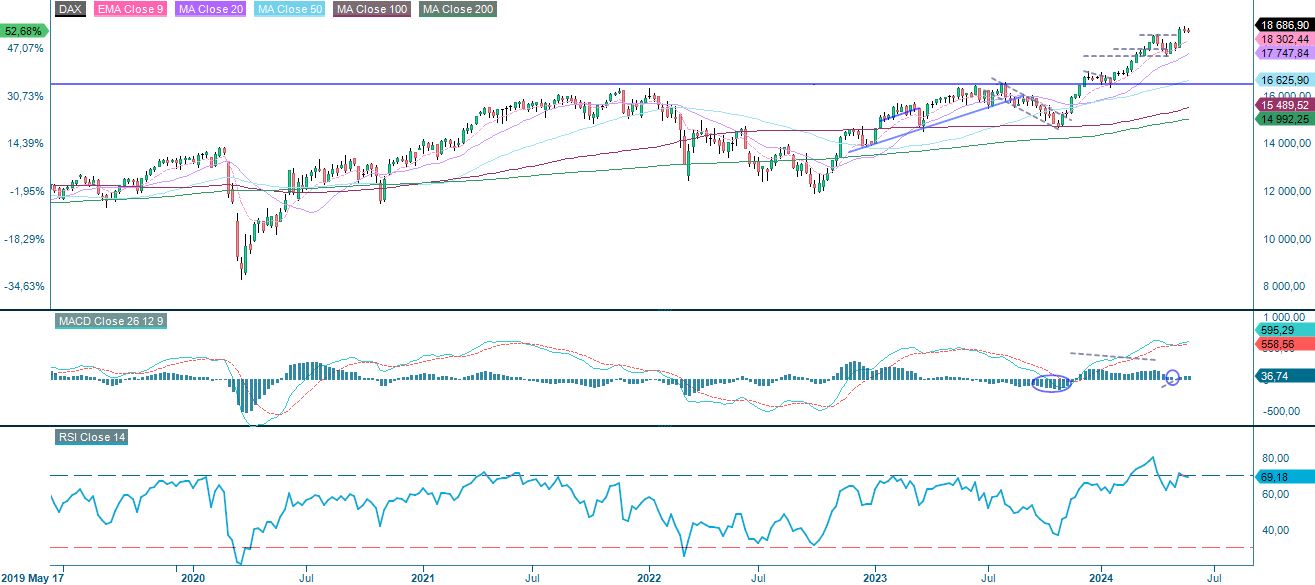
The full name for abbreviations used in the previous text:
EMA 9: 9-day exponential moving average
Fibonacci: There are several Fibonacci lines used in technical analysis. Fibonacci numbers are a sequence in which each successive number is the sum of the two previous numbers.
MA20: 20-day moving average
MA50: 50-day moving average
MA100: 100-day moving average
MA200: 200-day moving average
MACD: Moving average convergence divergence
Risks
External author:
This information is in the sole responsibility of the guest author and does not necessarily represent the opinion of Bank Vontobel Europe AG or any other company of the Vontobel Group. The further development of the index or a company as well as its share price depends on a large number of company-, group- and sector-specific as well as economic factors. When forming his investment decision, each investor must take into account the risk of price losses. Please note that investing in these products will not generate ongoing income.
The products are not capital protected, in the worst case a total loss of the invested capital is possible. In the event of insolvency of the issuer and the guarantor, the investor bears the risk of a total loss of his investment. In any case, investors should note that past performance and / or analysts' opinions are no adequate indicator of future performance. The performance of the underlyings depends on a variety of economic, entrepreneurial and political factors that should be taken into account in the formation of a market expectation.
Credit risk of the issuer:
Investors in the products are exposed to the risk that the Issuer or the Guarantor may not be able to meet its obligations under the products. A total loss of the invested capital is possible. The products are not subject to any deposit protection.
Market risk:
The value of the products can fall significantly below the purchase price due to changes in market factors, especially if the value of the underlying asset falls. The products are not capital-protected
Risk with leverage products:
Due to the leverage effect, there is an increased risk of loss (risk of total loss) with leverage products, e.g. Bull & Bear Certificates, Warrants and Mini Futures.
Product costs:
Product and possible financing costs reduce the value of the products.
Currency risk:
If the product currency differs from the currency of the underlying asset, the value of a product will also depend on the exchange rate between the respective currencies. As a result, the value of a product can fluctuate significantly.
